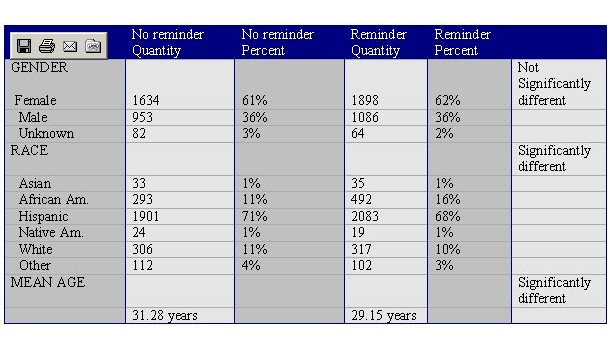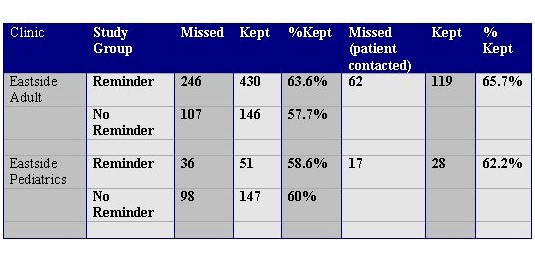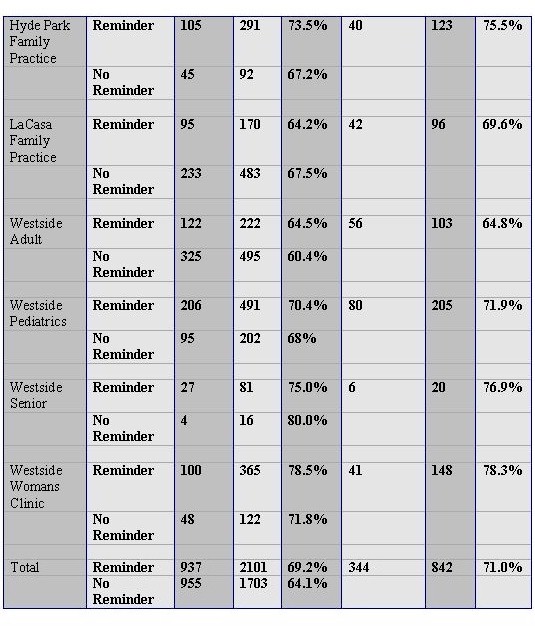|
|

Voice Broadcasting Auto Dialers
 Using our PACER and WIZARD voice broadcasting phone systems, we can broadcast voice messages and service announcements to your clients and community. Phone call messages can be automatically generated using our XML Push technology.
Using our PACER and WIZARD voice broadcasting phone systems, we can broadcast voice messages and service announcements to your clients and community. Phone call messages can be automatically generated using our XML Push technology.
Our phone message service can place one call or millions of calls. Pre-recorded messages can be played to either individuals and answering machines or just to individuals. Different messages can be played to an answering machine versus an individual.
Contact DSC today. to learn more about our voice broadcasting service and auto dialer phone systems.
The Effect of Computer Generated Appointment Reminders On Compliance With Clinic Appointments
Published: ISPUB.com The Internet Journal of Medical Simulation and Technology
Joel Witter, MD
Departments of Internal Medicine and Community Health
Denver Health and Hospital Authority
University of Colorado Department of Medicine
Denver Colorado USA
Andrew Steele, MD, MPH
Departments of Internal Medicine and Community Health
Denver Health and Hospital Authority
University of Colorado Department of Medicine
Denver Colorado USA
Dean McEwen
Departments of Internal Medicine and Community Health
Denver Health and Hospital Authority
University of Colorado Department of Medicine
Denver Colorado USA
Philip Mehler, MD
Departments of Internal Medicine and Community Health
Denver Health and Hospital Authority
University of Colorado Department of Medicine
Denver Colorado USA
Citation
Joel Witter, Andrew Steele, Dean McEwen, Philip Mehler: The Effect of Computer Generated Appointment Reminders On Compliance With Clinic Appointments. The Internet Journal of Medical Simulation and Technology. 2002. Volume 1 Number 1.
Introduction
Missed medical appointments are an important obstacle to the provision of effective health care. By failing to keep their appointments, patients disrupt the doctor-patient relationship, adversely affect clinic efficiency, and erode continuity of care. The benefits of continuity of care include a decrease in emergency department visits 1 2 3 4 , a decrease in the likelihood of future hospitalizations 5 6 , an increase in patient satisfaction 7 8 and the use of preventive health services 9 , and ultimately a decrease the cost of health care 10 . Moreover, there is decreased use of diagnostic tests and more reliance on judicious expectant management when as the result of the provision of continuity of care practitioners have a high level of accumulated knowledge regarding their patients 11 .
Decreasing the missed appointment rate can therefore be expected to improve continuity of care and the provision of effective health care.
Failure to keep appointments leads to increased administrative complexity and decreased revenues. Missed appointments also decrease access to care for other patients needing health care. Practitioners and administrators struggle with the resultant unpredictable patient volume, and often resort to overbooking patients in an attempt to maintain productivity. This in turn can lead to patient and staff dissatisfaction. All of these factors indirectly increase the cost of care. Unfortunately, missed appointments are common in many different health care settings; a review by Oppenheim et al found missed appointment rates ranged from 19% to 52% in a large variety of health care settings 12 . Increased missed appointments were noted in young adults, adults with young children, and low socioeconomic groups.
Several interventions, with varying degrees of success, have been designed and described in the medical literature in order to improve compliance with appointment keeping and decrease clinic no-show rates. Computer generated telephone messages may provide an inexpensive and effective means to improve clinic attendance. Evaluation of these systems has shown that they can improve immunization rates 13 14 and increase attendance in some public health clinics 15 . We decided to evaluate the effectiveness of a computer generated reminder system on kept appointment rates in an inner city public hospital system. Our hypothesis was that such a system would positively impact the kept appointment rates in primary care clinics in our integrated public health system.
Methods
Equipment: Computer Telephony Integration (CTI) is a computer-based application that automatically calls patients to remind them of their upcoming appointments. This program (BRITE) is interfaced with a computerized scheduling system to automatically download patient and appointment information. It uses an interactive voice response technology to call patients 24 to 72 hours before their appointment. The message delivers the appointment time and instructs the patient to call the clinic and cancel their appointment if necessary. Messages are given to the answering person in either English or Spanish. If there is no answer, the patient will be called back up to 5 times.
(Note: BRITE is manufactured by InterVoice of Dallas, Tx. The scheduling system used was INVISION Resource Scheduling from Seimens Medical Solutions Corporation, Malvern, PA. Denver Health and Hospital Authority has purchased both of these systems. No financial support was provided to the authors.)
Patient Population: Patients in this study receive their health care through Denver Health, a vertically integrated public health care system that includes Denver Health Medical Center, an urban hospital and ambulatory care center, and 11 community health centers, serving primarily minority, low income patients. Approximately 49% of the patients are Hispanic, 27% White, and 17% African-American. Nearly half of the patients lack any form of medical insurance, and the majority of the remainder receives health insurance through Medicaid or Medicare. In our health care system, however, low income does not preclude the ability to afford care because the Colorado Indigent Care Plan (CICP) uses an income based sliding scale to determine co-pay requirements and prescription costs to the patient.
Sample Selection: All patients with appointments scheduled at least 72 hours ahead of time at 7 Community Health Clinics over a period of 6 weeks were eligible for the study. During randomized alternating one week periods, patients at each of the clinics were assigned to receive automated appointment reminders (“reminder” group) versus the usual clinic procedure of no formal appointment reminder. Patients not receiving calls were used as the control group. 5,717 patients had appointments during this time and thus could have been called by the CTI system. Patients were asked if they would consent to a computerized reminder call at the time the appointment was made. Telephone numbers were also confirmed at this time.
Analytic Methods: Kept appointment rates were recorded for each of these groups. The reminder delivered rate (rate at which a reminder was actually delivered to a person or an answering device) in the computer reminder group was also recorded. Results were compared using a chi-square test.
Results
The demographics of the study patients in each of the appointment groups are shown in Table 1. Patients who were assigned to the reminder group were younger slightly younger and were more likely to be African American, although the great majority of the patients were Hispanic. Gender was similar between the two groups.
Table 1: Demographic characteristics of patients randomized to the reminder and no reminder groups in this study.

The kept appointment rates at each of the clinic sites, according to intervention group, are shown in Table 2. Also shown are the kept appointment rates for patients who were actually contacted by the voice messaging system. A total of 5,717 patients were eligible for the study, of which 3,048 were randomized to the reminder group and 2,669 to the control group. 2,617(86%) of the 3,048 patients in the “reminder” group were eligible to receive the reminder. The remaining 431 patients did not give permission to be contacted by the appointment system. Overall, the kept appointment rate was 69.2% in the reminder group compared to a kept appointment rate of 64.1% in the control group. This represents an 8% positive increase (p<0.01) and a large absolute increase in the numbers of kept appointments.
Table 2: Effect of Computerized Message Reminders on Kept Appointment Rates

 These results occurred even though only 1,192 of the 2,617 eligible reminder group patients were contacted by the system. The kept appointment rate among those patients who actually received the reminder was 71%, an increase of 10.8%.
These results occurred even though only 1,192 of the 2,617 eligible reminder group patients were contacted by the system. The kept appointment rate among those patients who actually received the reminder was 71%, an increase of 10.8%.
Discussion
The results of this study suggest that use of a computer generated appointment reminder system modestly increases the kept appointment rate in an urban community health environment. This increase occurred in a setting where kept appointment rates have traditionally been very low. Data from our institution and many other public hospital systems show a historical kept appointment rate of 68% to 72%. This low rate of kept appointments likely represents a combination of factors, including low socioeconomic status and lack of urgency relating to keeping the appointment (primary care visit versus urgent/emergency care visit), factors which have been shown to predict missed appointments in other studies 16 . It is precisely this historically difficult to reach population that our study addressed. The intervention did increase the kept appointment rate, albeit to a modest extent.
The magnitude of increase in the kept appointment rate was somewhat less than reported in other studies 17 18 . These studies addressed mostly pediatric populations, while our study addressed patients of all ages. It is possible that this intervention would have different effects on different age populations and is a potential area for future investigation.
Another potential reason for the lower than expected increase in the kept appointment rate was the failure of our system to actually contact a significant proportion of the patients who were called. Failure to contact a patient could represent several possibilities, including incorrect phone numbers in our system, disconnected phones, computer errors in processing phone calls, and contact attempts being made while the patient was unavailable. Difficulties interfacing the CTI system with the existing scheduling computer were encountered. Increased familiarity with the CTI system would be expected to resolve this problem and improve the efficiency of the system.
Finally, the patients in this study may not have been receptive to receiving an impersonal computer generated appointment reminder. Patients may therefore have chosen to ignore the message when answering their telephones. Some providers anecdotally reported patients who complained about the message that was received, although information about patient acceptance of the reminder system was not systematically collected. This study was not able to determine if the younger mean age (29.15 years vs. 31.28 years) and slight African-American prevalence in the reminder group affected the response to the computer message. Further investigation regarding patient acceptance of such a system would be helpful.
One of the limitations of this study included the diverse age range of the patients. While we chose to study the effects of this system in patients of all ages and in different clinic locations (representative of our clinic system as a whole), there were considerable variations in the effect of this system among the different clinics. While the results may be applicable to broad populations, the effect of the CTI system in a specific clinic may not be predictable. Another limitation was the performance of the CTI system. Although we estimate that about 90% of our patients have telephones, only about 50% of the eligible patients were actually contacted. We would expect that improved system performance could be achieved with increased familiarity with the system and would result in even higher kept appointment rates, although the net effect of a well functioning system remains to be seen.
Mailed reminders and telephone prompts have been found to be somewhat effective interventions in many outpatient settings 19 20 ; however, the high cost of mailings and the amount of labor involved prevent their widespread use by private clinics and public health systems. The use of a computer generated appointment reminder system resulted in an increase in the kept appointment rate of 8%. This increase could have considerable economic impact. In our community health system, there are about 300,000 patient visits a year, of which 57% are made 72 hours ahead of time. Thus 171,000 visits could potentially be impacted by implementation of the CTI system. An 8% increase in the kept appointment rate in 171,000 scheduled visits would represent almost 9,000 additional visits.
If the average charge for an outpatient visit is $177.35, the increase in visits represents about $1.5 million in increased charges. Unfortunately, charges do not necessarily represent receipts. This analysis does not take into account the additional indirect benefits of an increased rate of kept appointments such as improved health of a patient population and more efficient staffing and overall clinic administration.
The decision to implement such a system would have to be made on a site-specific basis. Telephone ownership in the target population, population acceptance of recorded messages, and a cost/benefit analysis would have to be taken into account. The cost of implementing this system in our large public health system was not insignificant; about $325,000 initially and an expected $125,000 a year for maintenance and upkeep. We calculate that a clinic would need to have patient base of about 40,000 patients in order to break even. These costs would probably be significantly less in smaller clinics.
Conclusion
In summary, missed appointments in primary care practice continue to have a deleterious effect on clinic efficiency along with a negative impact on healthcare revenues. Additional studies are warranted in an attempt to further the kept appointment rate. The introduction of a computerized reminder system had a modest beneficial effect on decreasing no show rates. A comparison of the demographic characteristics of the patients who continue to miss appointments with those who did not as a result of the computerized reminder might provide additional worthwhile information.
Correspondence to
Joel Witter, MD
Eastside Clinic
501 28 th St.
Denver, CO 80205
Phone (303)436-4604
Fax (303)436-4610
jwitter@dhha.org
References
1. Baker D, Stevens C, Brook R. Regular source of ambulatory care and medical care utilization by patients presenting to a public hospital emergency department. JAMA.1994:271:1909-1912
2. Christakis D, Wright J, Koepsell T, Emerson S, Connell F. Is greater continuity of care associated with less Emergency Department utilization? Pediatrics. 1999;103:738-742
3. Rosenblatt R, Wright G, Baldwin L, et al. The effect of the doctor-patient relationship on Emergency Department use in the elderly. Am J Public Health 2000;90:97-102
4. Gill J, Mainous A, Nsereko M. The effect of continuity of care on Emergency Department use. Arch Fam Med 2000;9:333-338
5. Mainous A, Gill J. The importance of continuity of care in the likelihood of future hospitalization: Is site of care equivalent to a primary physician? Am J Public Health 1998;88:1539-1541
6. Wasson J, Sauvigne A, Mogielnicki P, et al. Continuity of outpatient medical care in elderly men. JAMA 1984;2413-2417
7. ibid
8. Hjortdahl P, Laerum E. Continuity of care in general practice: Effect on patient satisfaction. BMJ 1992;304:1287-1290
9. Ettner S. The timing of preventive services for women and children: The effect of having a usual source of care. Am J Public Health 1996;48:1748-1754
10. Weiss L, Blustein J. Faithful patients: The effect of long term physician-patient relationships on the cost and use of health care in older Americans. Am J Public Health 1996;86:1742-1747
11. Hjortdahl P, Borchgrevink C. Continuity of care: Influence of general practitioners' knowledge about their patients on the use of resources in consultations. BMJ 1991;303:1181-1184
12. Oppenheim G, Bergam J, English E. Failed appointments: A review. J Fam Practice 1998;8:789-796
13. Leirer V, Morrow D, Pariante, G, Doksum T. Increasing influenza vaccination adherence through voice mail.J Am Geriatr Soc 1989;37:1147-1150
14. Linkins R, Dini E, Watson G, Patriarca P. A randomized trial of the effectiveness of computer generated telephone messages in increasing immunization visits among preschool children. Arch Pediatr Adolesc Med. 1994;148:908-914
15. Dini E, Linkins R, Chaney M. Effectiveness of computer generated telephone messages in increasing clinic visits. Arch Pediatr Adolesc Med. 1995;149:902-905
16. same source as reference 12
17. Dini E, Linkins R, Chaney M. same source as reference 17
18. Quattlebaum T, Darden P, Sperry L. Effectiveness of computer-generated appointment reminders. Pediatrics 1991;88(4):801-5
19. Gates S, Colborne D. Lowering appointment failure rates in a neighborhood health center. Medical care 1976;14:263-267
20. Shepard D, Mosley T. Mailed versus telephoned appointment reminders to reduce broken appointments in a hospital outpatient department. Medical Care 1976;14:268-273
What is Interactive Voice Response (IVR) and Voice Broadcasting (VB) and how can it be applied to different ivr applications?
Visit our Call Center Outsourcing web pages to learn more about these products and services.
Call Reminder Service with Phone Alert Reminders
 To quickly broadcast your call reminders and alerts, Database Systems Corp. offers a comprehensive phone reminder service. Pre-recorded messages can be played to either answering machines or to individuals informing them of upcoming conventions, community events, doctor or dental appointments, warranty repair notification, civil alerts, or marketing promotions. Different messages can be played to an answering machine versus an individual. Simple to complex scripts can be developed for touchphone response. Calls can be directed to operators that are standing by or can be transferred to outside third parties.
To quickly broadcast your call reminders and alerts, Database Systems Corp. offers a comprehensive phone reminder service. Pre-recorded messages can be played to either answering machines or to individuals informing them of upcoming conventions, community events, doctor or dental appointments, warranty repair notification, civil alerts, or marketing promotions. Different messages can be played to an answering machine versus an individual. Simple to complex scripts can be developed for touchphone response. Calls can be directed to operators that are standing by or can be transferred to outside third parties.
Personalized information from your custom database (such as name, appointment date and time) can be included in call notifications. In some campaigns, you may only want to leave a message if an answering machine is detected. In other campaigns, different messages can be played based upon contact with an answering machine or a person and based upon the time of day. An individual could be given a message with selection options using our interactive touchphone response system.
Calls can be routed to a remote company representative or to a group of service agents. Multiple message campaigns can be performed at the same time, each with its own set of business rules. Our call announcement system can conform to your specific requirements.
|



 Using our PACER and WIZARD
Using our PACER and WIZARD 


 To quickly broadcast your call reminders and alerts, Database Systems Corp. offers a comprehensive phone
To quickly broadcast your call reminders and alerts, Database Systems Corp. offers a comprehensive phone